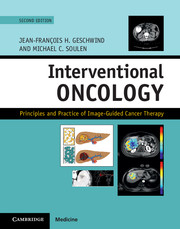Book contents
- Frontmatter
- Contents
- List of contributors
- Section I Principles of oncology
- Section II Principles of image-guided therapies
- Section III Organ-specific cancers – primary liver cancers
- 10 Assessment and triage of hepatocellular carcinoma
- 11 Image-guided ablation of hepatocellular carcinoma
- 12 Embolization of liver tumors: Anatomy
- 13 Conventional chemoembolization and chemoembolization with drug-eluting beads: Technique and future potential
- 14 90Yttrium radioembolization for hepatocellular carcinoma
- 15 Image-guided therapy of intrahepatic cholangiocarcinoma
- Section IV Organ-specific cancers – liver metastases
- Section V Organ-specific cancers – extrahepatic biliary cancer
- Section VI Organ-specific cancers – renal cell carcinoma
- Section VII Organ-specific cancers – chest
- Section VIII Organ-specific cancers – musculoskeletal
- Section IX Organ-specific cancers – prostate
- Section X Specialized interventional techniques in cancer care
- Index
- References
10 - Assessment and triage of hepatocellular carcinoma
from Section III - Organ-specific cancers – primary liver cancers
Published online by Cambridge University Press: 05 September 2016
- Frontmatter
- Contents
- List of contributors
- Section I Principles of oncology
- Section II Principles of image-guided therapies
- Section III Organ-specific cancers – primary liver cancers
- 10 Assessment and triage of hepatocellular carcinoma
- 11 Image-guided ablation of hepatocellular carcinoma
- 12 Embolization of liver tumors: Anatomy
- 13 Conventional chemoembolization and chemoembolization with drug-eluting beads: Technique and future potential
- 14 90Yttrium radioembolization for hepatocellular carcinoma
- 15 Image-guided therapy of intrahepatic cholangiocarcinoma
- Section IV Organ-specific cancers – liver metastases
- Section V Organ-specific cancers – extrahepatic biliary cancer
- Section VI Organ-specific cancers – renal cell carcinoma
- Section VII Organ-specific cancers – chest
- Section VIII Organ-specific cancers – musculoskeletal
- Section IX Organ-specific cancers – prostate
- Section X Specialized interventional techniques in cancer care
- Index
- References
Summary
Summary
Hepatocellular carcinoma (HCC) is the third leading cause of cancer-related death worldwide. Unlike most solid cancers, future incidence and mortality rates for HCC were projected to largely increase in several regions around the world over the next decade. Given the complexity of the disease and the common association of HCC and cirrhosis, careful multidisciplinary assessment of tumor stage, liver function, and physical status is required for proper staging and therapeutic planning. Patients with early-stage HCC should be considered for any of the available curative therapies, including liver transplantation, surgical resection, and image-guided ablation.
Transcatheter arterial chemoembolization is recommended as the standard of care for the treatment of large or multinodular non-invasive tumors in patients who have neither evidence of hepatic decompensation nor extrahepatic spread of the disease, i.e., those cases classified as intermediate stage according to the Barcelona Clinic for Liver Cancer (BCLC) staging system. Radioembolization with yttrium-90 (Y90) microspheres is increasingly used to treat patients at more advanced tumor stages, including those with portal vein invasion. The multitargeted tyrosine kinase inhibitor sorafenib is the only systemic treatment currently available for HCC patients unsuitable for surgical or interventional therapies. Despite the recent advances and refinements in therapeutic strategies, tumor recurrence remains a challenge in patients with HCC. Several clinical trials investigating different combinations of locoregional and systemic treatments for preventing early recurrence and improving long-term outcomes are ongoing.
Introduction
HCC is the third leading cause of cancer-related death worldwide. Unlike most solid cancers, future incidence and mortality rates for HCC were projected to largely increase in several regions around the world over the next decade, mostly as a result of the dissemination of hepatitis B and C virus infection. Patients with cirrhosis are at the highest risk of developing HCC and should be monitored every 6 months with imaging techniques to diagnose the tumor at an early, asymptomatic stage. Lesions detected by imaging surveillance require proper diagnostic approach. Confirmation of tiny nodules as true HCC may be challenging, as pathologic changes inherent in cirrhosis – such as regenerative or dysplastic nodules – mimic a small tumor. Treatment choice is also difficult, given the complexity of the disease and the large number of potentially useful therapies, and requires careful multidisciplinary assessment of tumor stage, liver function, and physical status.
- Type
- Chapter
- Information
- Interventional OncologyPrinciples and Practice of Image-Guided Cancer Therapy, pp. 85 - 90Publisher: Cambridge University PressPrint publication year: 2016



